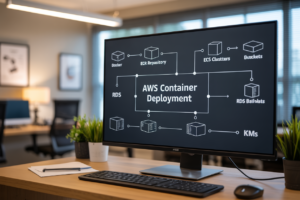Ever wondered how much time your team wastes on repetitive tasks that could be automated? The average employee spends 520 hours a year on mundane processes that could be handled by software. That’s over 13 weeks of work!
Automating your business processes with Salesforce isn’t just a nice-to-have anymore—it’s essential for companies that want to stay competitive and keep their best talent focused on what matters.
In this guide, we’ll walk through exactly how to automate your business processes with Salesforce, from basic workflow rules to complex approval processes. No jargon, no fluff—just practical steps you can implement this week.
But before we dive into the how-to, there’s one crucial mistake most businesses make when automating their processes that costs them thousands…
Understanding Business Process Automation with Salesforce
Key benefits for businesses of all sizes
Salesforce automation isn’t just for the big players. Small businesses save 20+ hours weekly on customer follow-ups while enterprise teams cut approval times by 70%. Your sales reps can ditch data entry and focus on closing deals. Plus, you’ll spot bottlenecks before they hurt your bottom line.
Common processes that can be automated
You know those mind-numbing tasks eating your day? Salesforce tackles them all. Lead routing gets contacts to the right rep instantly. Customer onboarding flows without your constant babysitting. Quote approvals that once took days happen in minutes. And those monthly reports? Generated automatically while you sleep.
Salesforce automation vs. traditional methods
| Traditional Methods | Salesforce Automation |
|---|---|
| Manual data entry | Automatic capture |
| Spreadsheet chaos | Centralized dashboard |
| Email approval chains | One-click workflows |
| Siloed information | Integrated systems |
| Weekly manual reports | Real-time insights |
ROI of implementing Salesforce automation
Most companies see payback within 6-8 months. One manufacturer cut order processing from 3 days to 4 hours. A financial services firm boosted customer response time by 65%. Your team handles 3x more cases without adding headcount. The numbers don’t lie – automation pays for itself, fast.
Setting Up Your Salesforce Environment for Automation
Setting Up Your Salesforce Environment for Automation
A. Essential configurations and permissions
Ever tried building a house without a foundation? Exactly. Before you dive into automation magic, you need the right setup. Start by configuring custom objects, fields, and record types that match your business processes. Then assign proper permission sets to your team—because nothing kills efficiency faster than “Sorry, you don’t have access to that.”
Leveraging Salesforce Workflow Rules
Leveraging Salesforce Workflow Rules
A. Creating condition-based automated actions
Want to stop doing the same tasks over and over? Workflow Rules are your best friend in Salesforce. Set up a trigger condition like “when a lead status changes to qualified,” and boom—your system kicks into action automatically. No more forgetting follow-ups or manual updates. Just build it once and let Salesforce handle the rest.
Mastering Process Builder for Complex Automation
Building multi-step automated processes
Process Builder isn’t just some boring tool. It’s your secret weapon for those headache-inducing workflows that make you want to pull your hair out. Drag-and-drop a few elements, set some conditions, and boom – you’ve got a multi-step process that runs while you grab coffee. No more manual updates across twenty fields.
Conditional logic and branching scenarios
Think of Process Builder as your workflow’s traffic cop. “If this happens, go here. If that happens, go there.” You can build branches more complex than a family tree, each with its own set of actions. Customer spent over $10K? Auto-assign to your VIP team. Under $100? Send to your standard queue.
Triggering processes from multiple objects
The real magic happens when you connect the dots between objects. Trigger a process when an opportunity closes, then automatically update related contacts, create follow-up tasks, and notify your team – all without writing a single line of code. It’s like having a digital assistant who never sleeps.
Implementing Flow Automation in Salesforce
Implementing Flow Automation in Salesforce
Visual workflow design fundamentals
Salesforce Flow’s drag-and-drop interface makes automation accessible to everyone. No coding required! Just grab the elements you need, connect them logically, and watch your business processes transform from manual headaches into smooth, automated experiences. Your team will wonder how they ever lived without it.
Advanced Automation with Apex and Lightning Components
Advanced Automation with Apex and Lightning Components
A. When to use code-based solutions
Sometimes those no-code tools just won’t cut it. When you need complex logic, custom user interfaces, or integration with external systems, Apex and Lightning Components become your best friends. They give you the power to build exactly what you need, even if it means writing a bit of code.
B. Creating custom automation controllers
Apex controllers are the brains behind your custom automation. They handle the heavy lifting—processing data, executing business logic, and returning results. Think of them as your personal assistants who follow your exact instructions, no matter how complicated.
C. Developing reusable components
Why build the same thing twice? Create Lightning components that you can drop into multiple projects. A well-designed date picker or custom data table can save you hours of work down the road. Plus, your users get a consistent experience across your org.
D. Performance considerations and limitations
Code is powerful, but it comes with responsibility. Watch those governor limits—they’ll bite you when you least expect it. Batch your operations, minimize database calls, and always test with realistic data volumes. Trust me, future you will be grateful.
Real-World Automation Case Studies
Real-World Automation Case Studies
A. Sales process automation examples
Check out how Tesla slashed their lead-to-close time by 45% using Salesforce automation. They ditched manual lead scoring and implemented an automated system that instantly routes hot prospects to the right sales reps. No more leads slipping through cracks or reps wasting time on poor-fit prospects.
Measuring Success and Optimizing Your Automation
Measuring Success and Optimizing Your Automation
A. Key performance indicators to track
You can’t improve what you don’t measure. Track time saved, error reduction, customer satisfaction scores, and conversion rates to gauge automation impact. Create dashboards that highlight these metrics in real-time, making it easy to spot bottlenecks and celebrate wins as your Salesforce automation matures.
B. Automation analytics and reporting
Salesforce’s built-in analytics tools aren’t just pretty charts—they’re your secret weapon. Use automation usage reports to see which processes get the most traction. Look for patterns in execution times and failure rates. The data doesn’t lie, and it’ll point you straight to what needs fixing or scaling up.
C. User adoption strategies
Automation dies without adoption. Get your team on board by showing them the “what’s in it for me” factor. Create quick video tutorials, offer hands-on training sessions, and celebrate power users. Consider a phased rollout approach—starting with enthusiastic early adopters who’ll become your in-house champions.
D. Continuous improvement methods
Automation isn’t a “set it and forget it” game. Schedule quarterly reviews to evaluate performance against your KPIs. Gather feedback from actual users—they’ll tell you what’s working and what’s driving them nuts. Test small improvements before full deployment. Remember, even tiny tweaks can lead to massive efficiency gains over time.
The journey to automating your business processes with Salesforce brings tremendous advantages to your organization. From setting up your environment and using simple workflow rules to implementing complex automation with Process Builder and Flow, Salesforce offers a comprehensive suite of tools that can transform your business operations. Advanced users can further extend functionality through Apex code and Lightning Components, creating truly customized solutions that address specific business needs.
As you implement automation in your organization, remember to measure results and continuously optimize your processes. The real-world case studies demonstrate that successful automation isn’t just about technology—it’s about thoughtfully mapping your business requirements and selecting the right tools for each scenario. Start small, focus on high-impact areas, and gradually expand your automation ecosystem. Your business will thank you with increased efficiency, reduced errors, and more time for your team to focus on what truly matters—delivering value to your customers.




















